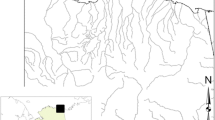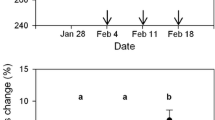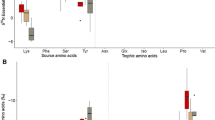Abstract
Long-distance bird migration is fueled by energy gathered at stopover sites along the migration route. The refueling rate at stopover sites is a determinant of time spent at stopovers and impacts the overall speed of migration. Refueling rate during spring migration may influence the fitness of individuals via changes in the probability of successful migration and reproduction during the subsequent breeding season. We evaluated four plasma lipid metabolites (triglycerides, phospholipids, β-OH-butyrate, and glycerol) as measures of refueling rate in free-living semipalmated sandpipers (Calidris pusilla) captured at non-breeding areas. We described the spatial and temporal variation in metabolite concentrations among one winter site in the Dominican Republic and four stopover sites in the South Atlantic and Mid-Atlantic Coastal Plain regions of North America. Triglycerides and β-OH-butyrate clearly identified spatial variation in refueling rate and stopover habitat quality. Metabolite profiles indicated that birds had higher refueling rates at one site in the Mid-Atlantic Coastal Plain than at three sites on the South Atlantic Coastal Plain and one site in the Dominican Republic. Temporal variation in lipid metabolites during the migration season suggested that male semipalmated sandpipers gained more weight at stopovers on the South Atlantic Coastal Plain than did females, evidence of differential migration strategies for the sexes. Plasma lipid metabolites provide information on migration physiology that may help determine stopover habitat quality and reveal how migratory populations use stopover sites to refuel and successfully complete long-distance migrations.


Similar content being viewed by others
References
Akaike H (1973) Information theory as an extension of the maximum likelihood principle. In: Petrov BN, Csaki F (eds) Second international symposium on information theory. Akademiai Kiado, Budapest, pp 267–281
Alerstam T, Lindström Å (1990) Optimal bird migration: the relative importance of time, energy, and safety. In: Gwinner E (ed) Bird migration: physiology and ecophysiology. Springer, Berlin, pp 331–351
Baker AJ, González PM, Piersma T, Niles LJ, de Lima Serrano do Nascimento I, Atkinson PW, Clark NA, Minton CDT, Peck MK, Aarts G (2004) Rapid population decline in red knots: fitness consequences of decreased refuelling rates and late arrival in Delaware Bay. Proc R Soc Lond B 271:875–882
Buck DG, Brenner M, Hodell DA, Curtis JH, Martin JB, Pagani M (2005) Physical and chemical properties of hypersaline Lago Enriquillo, Dominican Republic. Verh Int Verein Limnol 29:725–731
Burnham KP, Anderson DR (2002) Model selection and multimodel inference: a practical information-theoretic approach. Springer, New York
Castro G, Myers J (1993) Shorebird predation on eggs of horseshoe crabs during spring stopover on Delaware Bay. Auk 110:927–930
Cerasale DJ, Guglielmo CG (2006a) Dietary effects on prediction of body mass changes in birds by plasma metabolites. Auk 123:836–846
Cerasale DJ, Guglielmo CG (2006b) Plasma metabolite profiles: effects of dietary phospholipids in a migratory passerine (Zonotrichia leucophrys gambelii). Physiol Biochem Zool 79:754–762
Collazo JA, O’Harra DA, Kelly CA (2002) Accessible habitat for shorebirds: Factors influencing its availability and conservation implications. Waterbirds 25(Special Publication 2):13–24
Davidson NC (1983) Formulae for estimating the lean weight and fat reserves of live shorebirds. Ring Migr 4:159–166
Gratto-Trevor CL (1992) Semipalmated sandpiper. In: Poole A, Stettenheim P, Gill F (eds) The birds of North America, no. 6. Academy of Natural Sciences, Philadelphia
Guglielmo CG, O’Hara PD, Williams TD (2002a) Extrinsic and intrinsic sources of variation in plasma lipid metabolites of free-living western sandpipers (Calidris mauri). Auk 119:437–445
Guglielmo CG, Williams TD, Zwingelstein G, Brichon G, Weber J (2002b) Plasma and muscle phospholipids are involved in the metabolic response to long-distance migration in a shorebird. J Comp Physiol B 172:409–417
Guglielmo CG, Cerasale DJ, Eldermire C (2005) A field validation of plasma metabolite profiling to assess refueling performance of migratory birds. Physiol Biochem Zool 78:116–125
Harrington B, Morrison R (1979) Semipalmated sandpiper migration in North America. In: Pitelka F (eds) Studies in avian biology, vol 2. Cooper Ornithological Society, Camarillo, pp 83–100
Herring G, Collazo JA (2001) Habitat quality and use by waterfowl in impounded wetlands under various hydrological treatments and adjacent estuarine areas at Merritt Island National Wildlife Refuge. North Carolina State University, Raleigh
Herring G, Collazo JA (2005) Habitat use, movements, and home range of wintering lesser scaup in Florida. Waterbirds 28:71–78
Hurvich C, Tsai C-L (1989) Regression and time series model selection in small samples. Biometrika 76:297–307
Jenni-Eiermann S, Jenni L (1994) Plasma metabolite levels predict individual body-mass changes in a small long-distance migrant, the garden warbler. Auk 11:888–899
Lyons JE (1994) Eco-physiology of shorebirds during winter and migration at South Island, South Carolina. M.S. thesis, Clemson University
Lyons JE, Haig SM (1995) Fat content and stopover ecology of spring migrant semipalmated sandpipers in South Carolina. Condor 97:427–437
Mizrahi D, Peters K (2006) Semipalmated and least sandpiper stopover dynamics on Delaware Bay during spring migration. New Jersey Audubon, Cape May Court House
Morrison R (1984) Migration systems of some New World shorebirds. In: Burger J, Olla B (eds) Behavior of marine animals, vol 6. Plenum, New York, pp 125–202
Prater T, Marchant J, Vuorinen J (1977) Guide to the identification and ageing of Holarctic waders. British Trust for Ornithology, Tring
Provancha JA, Sheidt DM (2000) Long-term trends in seagrass beds in the Mosquito Lagoon and northern Banana River, Florida. In: Dennish MJ (ed) Seagrasses: monitoring, ecology, physiology, and management. CRC, Boca Raton, pp 177–193
Ramenofsky M (1990) Fat storage and fat metabolism in relation to migration. In: Gwinner E (ed) Bird migration: physiology and ecophysiology. Springer, New York, pp 214–231
Rice S, Collazo JA, Alldredge M, Harrington B, Lewis A (2007) Local annual survival and seasonal residency rates of semipalmated sandpipers in Puerto Rico. Auk 124:1397–1406
SAS Institute (2004) SAS OnlineDoc 9.1.3. SAS Institute, Cary
Schaub M, Jenni L (2001) Variation in fuelling rates among sites, days and individuals in migrating passerine birds. Funct Ecol 15:584–594
Seaman DA, Guglielmo CG, Williams TD (2005) Effects of physiological state, mass change and diet on plasma metabolite profiles in western sandpiper Calidris mauri. J Exp Biol 208:761–769
Seaman DAA, Guglielmo CG, Elner RW, Williams TD (2006) Landscape-scale physiology: site differences in refueling rates indicated by plasma metabolite analysis in free-living migratory sandpipers. Auk 123:563–574
Skagen SK (2006) Migration stopovers and the conservation of arctic-breeding calidridine sandpipers. Auk 123:313–322
Stevens L (1996) Avian biochemistry and molecular biology. Cambridge University Press, Cambridge
Summers RW (1988) The use of linear measurements when comparing masses. Bird Study 36:77–79
Thomas GH, Lanctot RB, Szekely T (2006) Can intrinsic factors explain population declines in North American breeding shorebirds? A comparative analysis. Anim Conserv 9:252–258
Tsipoura N, Burger J (1999) Shorebird diet during spring migration stopover on Delaware Bay. Condor 101:635–644
Weber LM, Haig SM (1997) Shorebird–prey interactions in South Carolina coastal soft sediments. Can J Zool 75:245–252
Wenner EL (1987) Benthic macrofauna. In: DeVoe MR, Baughman DS (eds) South Carolina coastal wetland impoundments, vol II. South Carolina Sea Grant Consortium, Charleston, pp 255–293
Wetlands International (2002) Waterbird population estimates, 3rd edn. Wetlands International, Wageningen
Williams TD, Guglielmo CG, Egeler O, Martyniuk CJ (1999) Plasma lipid metabolites provide information on mass change over several days in captive western sandpipers. Auk 116:994–1000
Williams TD, Warnock N, Takekawa JY, Bishop MA (2007) Flyway scale variation in plasma triglyceride levels as an index of refueling rate in spring migrating western sandpipers. Auk 124:886–897
Winker K, Warner DW, Weisbrod AR (1992) Daily mass gains among woodland migrants at an inland stopover site. Auk 109:853–862
Zöckler C, Delany S, Hagemeijer W (2003) Wader populations are declining—how will we elucidate the reasons? Wader Study Group Bull 100:202–211
Acknowledgements
We thank Aaron Brees, Francisco Collazo, Garth Herring, Jeff Hostetler, and Jordan Perkins for excellent assistance in the field. Sarah Converse and two anonymous reviewers provide valuable comments on the manuscript. Several individuals and institutions provided logistical support and we would like to specifically thank Robert Joyner, YWC; Marc Epstein, Merritt Island NWR; Bob Noffsinger, Pea Island NWR; and David Mizrahi, New Jersey Audubon Society. This work was funded by the Species at Risk Program of the U.S. Geological Survey and approved by the North Carolina State University Institutional Animal Care and Use Committee (permit 01-050-0).
Author information
Authors and Affiliations
Corresponding author
Additional information
Communicated by Carol Vleck.
Rights and permissions
About this article
Cite this article
Lyons, J.E., Collazo, J.A. & Guglielmo, C.G. Plasma metabolites and migration physiology of semipalmated sandpipers: refueling performance at five latitudes. Oecologia 155, 417–427 (2008). https://doi.org/10.1007/s00442-007-0921-x
Received:
Accepted:
Published:
Issue Date:
DOI: https://doi.org/10.1007/s00442-007-0921-x




